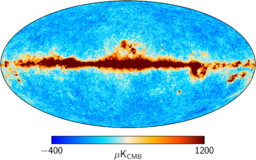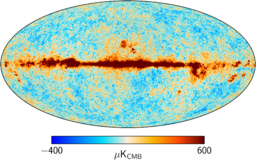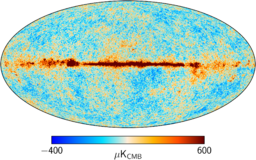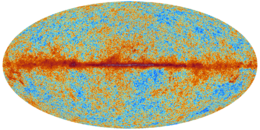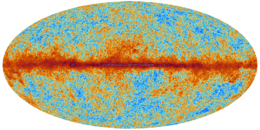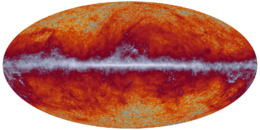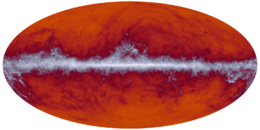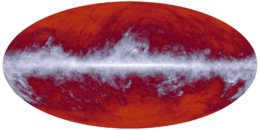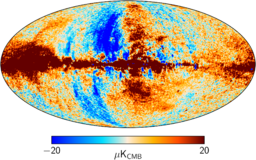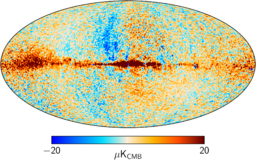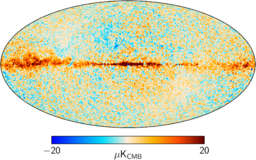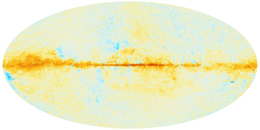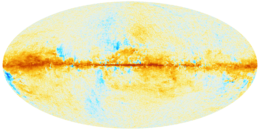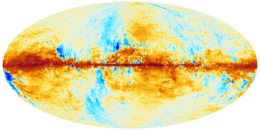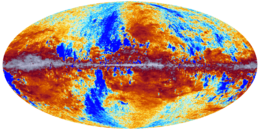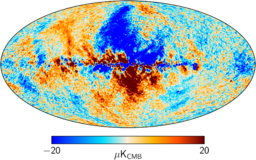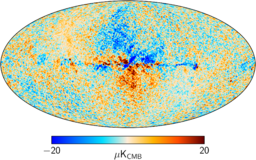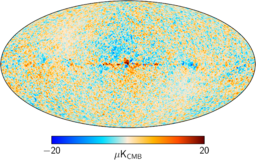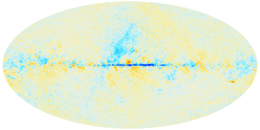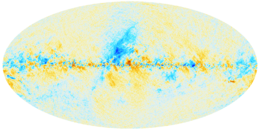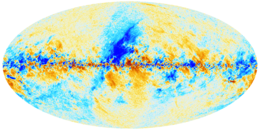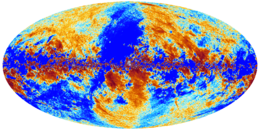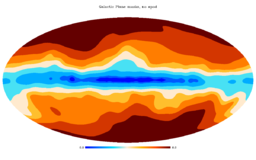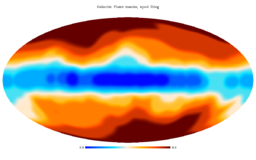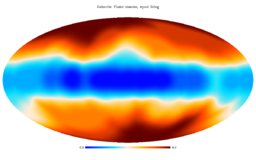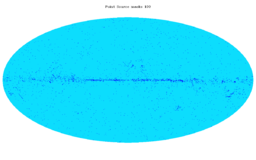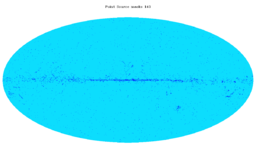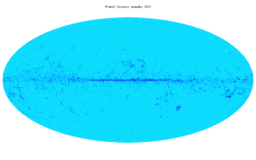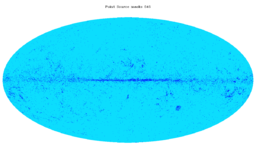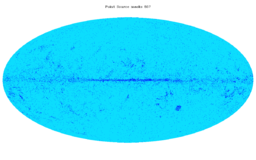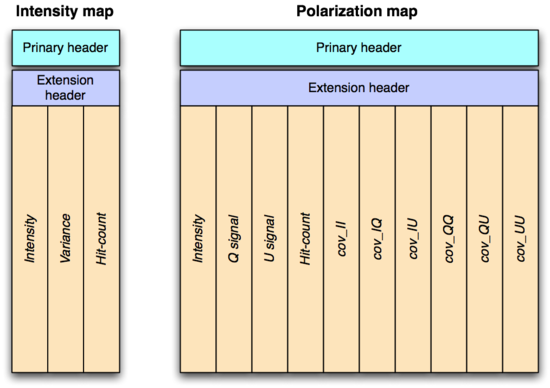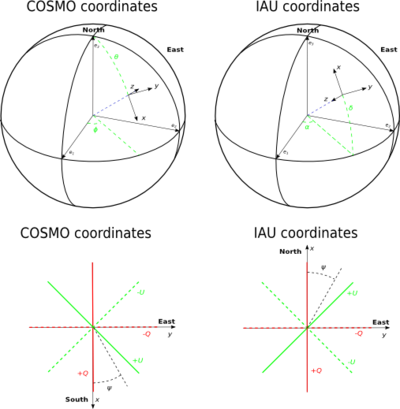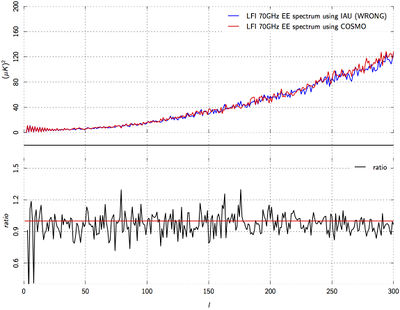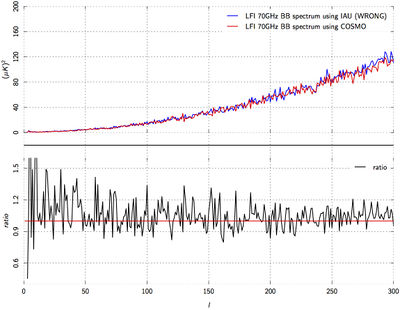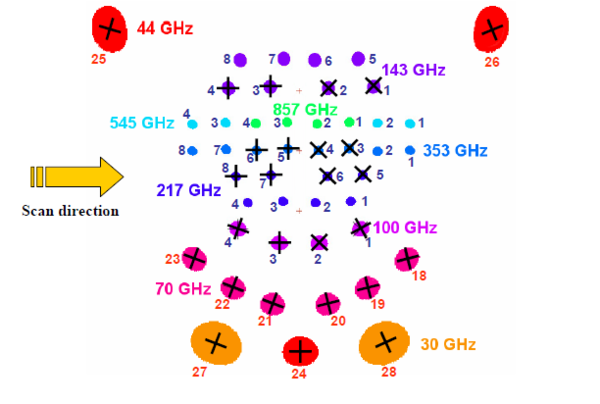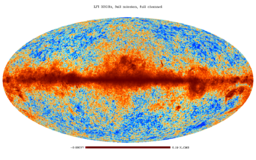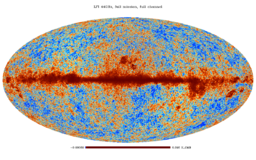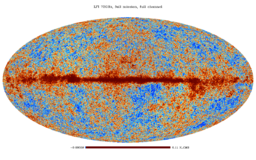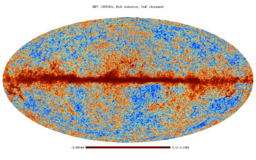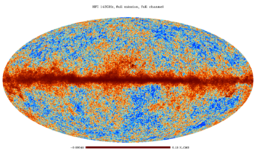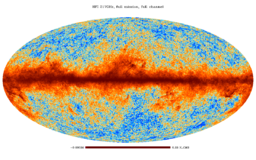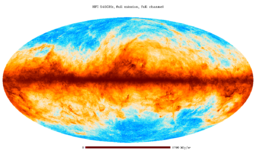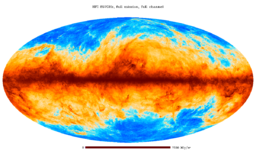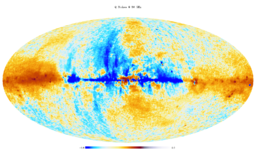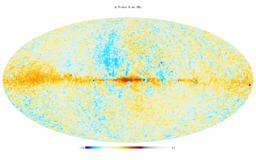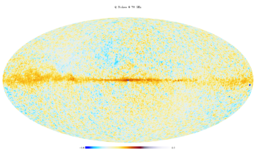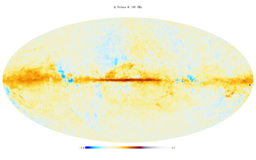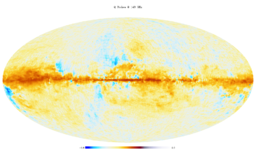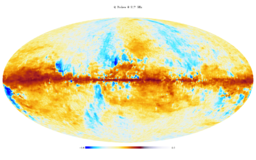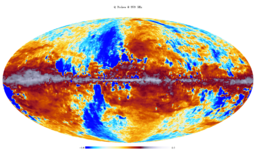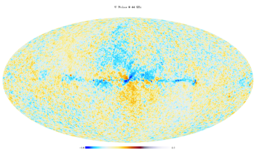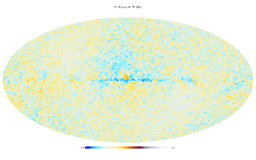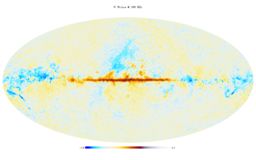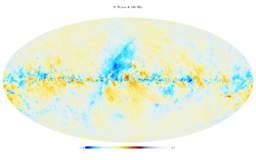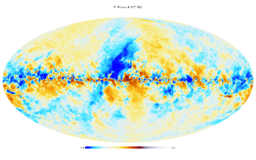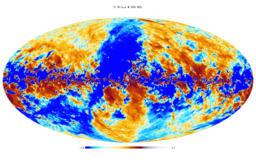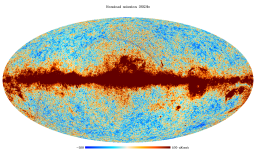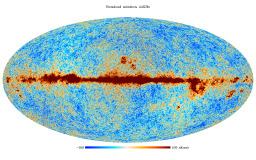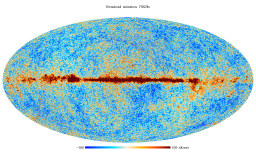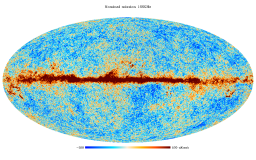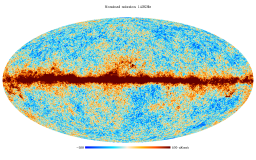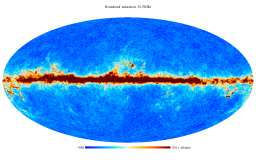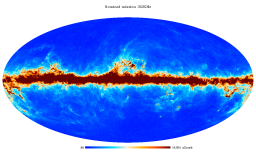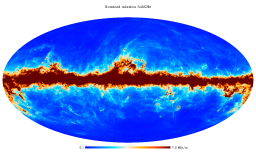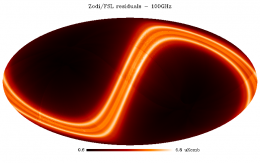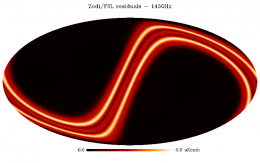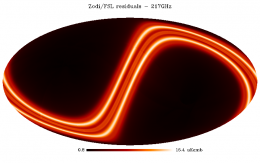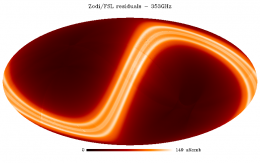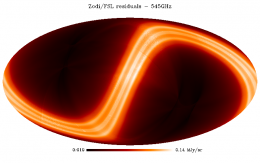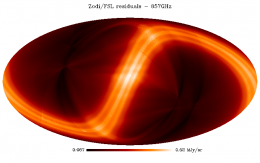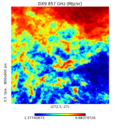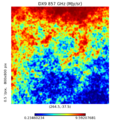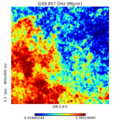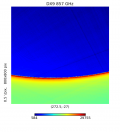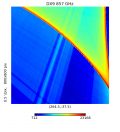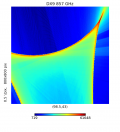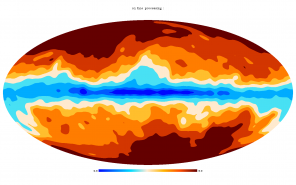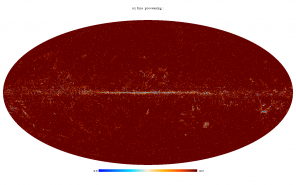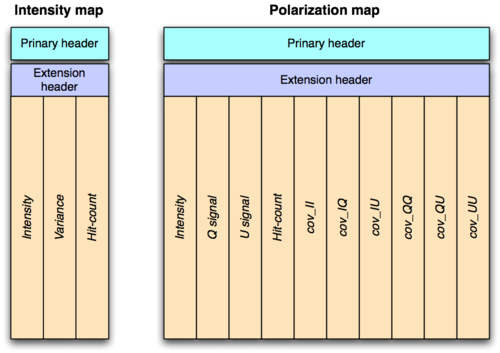Difference between revisions of "Frequency maps"
(→File names) |
(→Other releases: 2020-NPIPE, 2015 and 2013) |
||
| (26 intermediate revisions by 3 users not shown) | |||
| Line 2: | Line 2: | ||
==General description== | ==General description== | ||
| − | Sky maps give the best estimate of the intensity and polarization (Stokes <i>Q</i> and <i>U</i> components), if available, of the signal from the sky after removal, as far as possible, of known systematic effects (mostly instrumental, but including also the solar and Earth-motion dipoles, Galactic stray light, and the zodiacal light). The Planck Collaboration has made three releases of maps, in 2013, 2015 and 2018. This section describes the 2018 release. For descriptions of the other two releases, please go to 2013 | + | Sky maps give the best estimate of the intensity and polarization (Stokes <i>Q</i> and <i>U</i> components), if available, of the signal from the sky after removal, as far as possible, of known systematic effects (mostly instrumental, but including also the solar and Earth-motion dipoles, Galactic stray light, and the zodiacal light). The Planck Collaboration has made three releases of maps, in 2013, 2015 and 2018. This section describes the 2018 release. For descriptions of the other two releases, please go to the sections at the end of this chapter related to 2013 and 2015. |
In the 2013, 2015 and 2018 releases, sky maps are provided for the full Planck mission using all valid detectors in each frequency channel, and also for various subsets obtained by splitting the mission into various time ranges or into subsets of the detectors in a given channel, or by considering only odd or even pointing periods. These products are especially interesting for characterization purposes (see also the [[HFI-Validation | data validation]] section), though some are also useful for the study of source variability. The details of the start and end of the time ranges are given in the table below. | In the 2013, 2015 and 2018 releases, sky maps are provided for the full Planck mission using all valid detectors in each frequency channel, and also for various subsets obtained by splitting the mission into various time ranges or into subsets of the detectors in a given channel, or by considering only odd or even pointing periods. These products are especially interesting for characterization purposes (see also the [[HFI-Validation | data validation]] section), though some are also useful for the study of source variability. The details of the start and end of the time ranges are given in the table below. | ||
| Line 174: | Line 174: | ||
File: LFI_044GHz_dx12_I.png| '''Full mission <i>I</i>, 44 GHz.''' | File: LFI_044GHz_dx12_I.png| '''Full mission <i>I</i>, 44 GHz.''' | ||
File: LFI_070GHz_dx12_I.png| '''Full mission <i>I</i>, 70 GHz.''' | File: LFI_070GHz_dx12_I.png| '''Full mission <i>I</i>, 70 GHz.''' | ||
| − | File: | + | File: HFI_SkyMap_100_2048_R3.00_full_T.png| '''Full mission <i>I</i>, 100 GHz.''' |
| − | File: | + | File: HFI_SkyMap_143_2048_R3.00_full_T.png| '''Full mission <i>I</i>, 143 GHz.''' |
| − | File: | + | File: HFI_SkyMap_217_2048_R3.00_full_T.png| '''Full mission <i>I</i>, 217 GHz.''' |
| − | File: | + | File: HFI_SkyMap_353-psb_2048_R3.00_full_T.png| '''Full mission <i>I</i>, 353 GHz.''' |
| − | File: | + | File: HFI_SkyMap_545_2048_R3.00_full_T.png| '''Full mission <i>I</i>, 545 GHz.''' |
| − | File: | + | File: HFI_SkyMap_857_2048_R3.00_full_T.png| '''Full mission <i>I</i>, 857 GHz.''' |
</gallery> | </gallery> | ||
</center> | </center> | ||
| Line 188: | Line 188: | ||
File: LFI_044GHz_dx12_Q.png | '''Full mission <i>Q</i>, 44 GHz.''' | File: LFI_044GHz_dx12_Q.png | '''Full mission <i>Q</i>, 44 GHz.''' | ||
File: LFI_070GHz_dx12_Q.png | '''Full mission <i>Q</i>, 70 GHz.''' | File: LFI_070GHz_dx12_Q.png | '''Full mission <i>Q</i>, 70 GHz.''' | ||
| − | File: | + | File: HFI_SkyMap_100_2048_R3.00_full_Q_sm30arcmin.png | '''Full mission <i>Q</i>, 100 GHz.''' |
| − | File: | + | File: HFI_SkyMap_143_2048_R3.00_full_Q_sm30arcmin.png | '''Full mission <i>Q</i>, 143 GHz.''' |
| − | File: | + | File: HFI_SkyMap_217_2048_R3.00_full_Q_sm30arcmin.png | '''Full mission <i>Q</i>, 217 GHz.''' |
| − | File: | + | File: HFI_SkyMap_353-psb_2048_R3.00_full_Q_sm30arcmin.png | '''Full mission <i>Q</i>, 353 GHz.''' |
</gallery> | </gallery> | ||
</center> | </center> | ||
| Line 200: | Line 200: | ||
File: LFI_044GHz_dx12_U.png | '''Full mission <i>U</i>, 44 GHz.''' | File: LFI_044GHz_dx12_U.png | '''Full mission <i>U</i>, 44 GHz.''' | ||
File: LFI_070GHz_dx12_U.png | '''Full mission <i>U</i>, 70 GHz.''' | File: LFI_070GHz_dx12_U.png | '''Full mission <i>U</i>, 70 GHz.''' | ||
| − | File: | + | File: HFI_SkyMap_100_2048_R3.00_full_U_sm30arcmin.png | '''Full mission <i>U</i>, 100 GHz.''' |
| − | File: | + | File: HFI_SkyMap_143_2048_R3.00_full_U_sm30arcmin.png | '''Full mission <i>U</i>, 143 GHz.''' |
| − | File: | + | File: HFI_SkyMap_217_2048_R3.00_full_U_sm30arcmin.png | '''Full mission <i>U</i>, 217 GHz.''' |
| − | File: | + | File: HFI_SkyMap_353-psb_2048_R3.00_full_U_sm30arcmin.png | '''Full mission <i>U</i>, 353 GHz.''' |
</gallery> | </gallery> | ||
| Line 261: | Line 261: | ||
=== Caveats and known issues === | === Caveats and known issues === | ||
| − | + | ==== HFI frequency maps ==== | |
| + | Some imperfections have shown up in the tests of the HFI PR3 maps that were previously hidden by higher-level systematics in the previous PR2 data. These lead to guidelines for the proper use of the HFI PR3 data. See {{PlanckPapers|planck2016-l03}} for a detailed description of all these issues. | ||
| − | = | + | <span style="color:#ff0000"> Update 12 Sep 2018:</span> Covariance matrices in PR3.00 frequency maps FITS files were not correctly computed and contained wrong values. They must not be used for any purpose. These maps have been removed from the PLA. Version 3.01 must be used instead. Intensity, polarization and hit count maps have not changed. |
| − | |||
===== Monopoles ===== | ===== Monopoles ===== | ||
| − | Monopoles, which cannot be extracted from Planck data alone, are adjusted at each frequency (as was done in the previous PR2 release). For component separation, this provides maps that can be used directly in combination with other tracers. | + | Monopoles, which cannot be extracted from Planck data alone, are adjusted at each frequency (as was done in the previous PR2 release). For component separation, this provides maps that can be used directly in combination with other tracers. See {{PlanckPapers|planck2016-l03}} for a detailed discussion. |
| − | + | In the 2018 maps, three monopoles have been adjusted: | |
| + | * during production of the HFI frequency maps, an HI correlation analysis is carried out to adjust the overall monopole of the map to be consistent with the intensity of the Galactic dust foreground at high galactic latitudes (this adjustment was also done in the 2016 maps) | ||
| + | * a monopole corresponding to the zero-level of the CIB (Cosmic Infrared Background) estimated from a galaxy evolution model has been added to the maps (as for the 2016 maps) | ||
| + | * a monopole corresponding to the zero-level of zodiacal emission, representative of the high ecliptic latitude emission regions, has been added to the maps (note that this was not done in the 2016 maps). | ||
| + | It is recommended that for work separating CMB and diffuse Galactic components from HFI frequency maps, the CIB and Zodiacal emission monopoles should first be removed. Furthermore, especially for applications at low intensity, it is critical to appreciate that there are significant uncertainties in the zero levels in the Galactic maps. It is therefore also recommended that the maps be correlated with the HI map at high latitude, following the detailed methodology set out in {{PlanckPapers|planck2013-p03b}} and {{PlanckPapers||planck2013-p06}}. Consideration should also be given to the possible effect of dust in the warm ionized medium, as discussed and quantified in {{PlanckPapers||planck2016-l12}}. | ||
| + | |||
| + | ===== Solar dipole residual===== | ||
| + | The ''Planck'' 2015 Solar dipole is removed from the PR3 HFI maps to be consistent with LFI maps and to facilitate comparison with the previous PR2 ones. The best Solar dipole determination from HFI PR3 data shows a small shift in direction of about 1', but a 1.8 μK lower amplitude. Removal of the ''Planck'' 2015 Solar dipole thus leaves a small but non-negligible dipole residual in the HFI PR3 maps. To correct for this, and adjust maps at the best photometric calibration, users of the HFI PR3 maps should: | ||
| + | # put back into the maps the ''Planck'' 2015 Solar dipole (d,l,b)= (3364.5 ± 2.0 μK, 264.00 ± 0.03°, 48.24 ± 0.02°), | ||
| + | # include the [[#Calibration accuracy|absolute calibration frequency bias]], i.e., multiply by 1 minus the calibration bias, | ||
| + | # lastly, remove the [[#HFI 2018 Solar dipole|HFI 2018 Solar dipole]]. | ||
=====Use of the 353 GHz SWBs ===== | =====Use of the 353 GHz SWBs ===== | ||
| − | + | In 2018, two types of maps at 353 GHz are provided, one including only PSBs and one including both PSBs and SWBs. For reasons detailed in {{planckPapers|planck2016-l03}}, it is recommended to use the former (i.e. only including PSBs). The alternative one including the 353 GHz SWBs should be used only for specific uses such as, for example, increasing the signal to noise level at high multipoles. | |
===== Color correction and component separation===== | ===== Color correction and component separation===== | ||
| − | + | In 2018 the SRoll algorithm has been used to produce the frequency maps. This algorithms adjusts by construction all single bolometer maps to the band average response. For this reason, it becomes impossible to use the different individual bolometer responses to extract foreground component maps, and the individual bolometer maps are not provided as part of the release. See {{PlanckPapers|planck2016-l03}} for a detailed description. Note also that for the same reason, the effective bandpass response of the 2018 maps is not the same as for the 2015 maps. The new bandpass response is established in the 2018 RIMO. | |
| − | ===== Sub-pixel | + | ===== Sub-pixel effects in very bright regions===== |
| − | The bandpass corrections have been optimized for high latitude regions which implied to reduce the noise of the CO and dust bandpass templates to avoid the introduction of significant correlated noise. The effect is negligible for dust but not for CO in very bright regions. See [[subpixel_HFI| | + | The bandpass corrections have been optimized for high latitude regions which implied to reduce the noise of the CO and dust bandpass templates to avoid the introduction of significant correlated noise. The effect is negligible for dust but not for CO in very bright regions. As a consequence, some systematic effects (which appear as striping) appear in some of the maps in the brightest galactic emission regions. See [[subpixel_HFI|detailed description]]. |
| − | ==== | + | ==== LFI Frequency maps ==== |
| − | + | ||
| − | + | '''TBD''' | |
| − | |||
| − | |||
==Inputs== | ==Inputs== | ||
| Line 309: | Line 317: | ||
Note that for this release, HFI has not produced any new masks. | Note that for this release, HFI has not produced any new masks. | ||
| − | + | ====Point source masks ==== | |
| − | |||
| − | |||
| − | |||
| − | |||
| − | ====Point source masks | ||
For HFI and LFI two sets of point-source masks are provided. | For HFI and LFI two sets of point-source masks are provided. | ||
| Line 322: | Line 325: | ||
Both sets of masks are found in the files ''HFI_Mask_PointSrc_2048_R2.00.fits'' and ''LFI_Mask_PointSrc_2048_R2.00.fits'', in which the first extension contains the intensity masks, and the second contains the polarization masks. | Both sets of masks are found in the files ''HFI_Mask_PointSrc_2048_R2.00.fits'' and ''LFI_Mask_PointSrc_2048_R2.00.fits'', in which the first extension contains the intensity masks, and the second contains the polarization masks. | ||
| − | ====Galactic plane masks | + | ====Galactic plane masks ==== |
Eight Galactic emission masks are provided, giving 20, 40, 60, 70, 80, 90, 97, and 99% sky coverage, derived from the 353 GHz map after CMB subtraction. These are independent of frequency channel. Three versions are given: not apodized; and apodized by 2° and 5°. The filenames are ''HFI_Mask_GalPlane-apoN_2048_R2.00.fits'', where <i>N</i> = 0, 2, and 5. | Eight Galactic emission masks are provided, giving 20, 40, 60, 70, 80, 90, 97, and 99% sky coverage, derived from the 353 GHz map after CMB subtraction. These are independent of frequency channel. Three versions are given: not apodized; and apodized by 2° and 5°. The filenames are ''HFI_Mask_GalPlane-apoN_2048_R2.00.fits'', where <i>N</i> = 0, 2, and 5. | ||
| Line 357: | Line 360: | ||
|} | |} | ||
| − | {| class="wikitable" align="center" style="text-align"left" border="1" cellpadding="15" cellspacing="20" width= | + | {| class="wikitable" align="center" style="text-align"left" border="1" cellpadding="15" cellspacing="20" width=1600px |
|+ '''LFI FITS filenames''' | |+ '''LFI FITS filenames''' | ||
|- bgcolor="ffdead" | |- bgcolor="ffdead" | ||
! Coverage || Filename || Half-ring filename || Comment | ! Coverage || Filename || Half-ring filename || Comment | ||
|- | |- | ||
| − | | Full channel, full mission ||LFI_SkyMap_???_1024_R3.??_full.fits ||LFI_SkyMap_??? | + | | Full channel, full mission ||LFI_SkyMap_???_1024_R3.??_full.fits ||LFI_SkyMap_???_1024_R3.??_full-ringhalf-?.fits || 70GHz is corrected for Template |
|- | |- | ||
| − | | Full channel, full mission ||LFI_SkyMap_???-BPassCorrected_1024_R3.??_full.fits ||LFI_SkyMap_???-BPassCorrected_??? | + | | Full channel, full mission BandPass corrected ||LFI_SkyMap_???-BPassCorrected_1024_R3.??_full.fits ||LFI_SkyMap_???-BPassCorrected_???_1024_R3.??_full-ringhalf-?.fits || 70GHz is corrected for Template |
|- | |- | ||
| − | | Full channel, single survey || LFI_SkyMap_???_1024_R3.??_survey-?.fits || n/a || | + | | Full channel, single survey || LFI_SkyMap_???_1024_R3.??_survey-?.fits || n/a || n/a |
|- | |- | ||
| Full channel, survey combination || LFI_SkyMap_???_1024_R3.??_survey-1-3-5-6-7-8.fits || n/a || n/a | | Full channel, survey combination || LFI_SkyMap_???_1024_R3.??_survey-1-3-5-6-7-8.fits || n/a || n/a | ||
|- | |- | ||
| − | | Full channel, survey combination || LFI_SkyMap_???_1024_R3.?? | + | | Full channel, survey combination BandPass corrected|| LFI_SkyMap_???_1024_R3.??-BPassCorrected_survey-1-3-5-6-7-8.fits || n/a || n/a |
|- | |- | ||
| − | | Full channel, single year || LFI_SkyMap_??? | + | | Full channel, single year || LFI_SkyMap_???_1024_R3.??_year-?.fits || n/a || n/a |
|- | |- | ||
| − | | Full channel, single year || LFI_SkyMap_???-BPassCorrected_1024_R3.??_year-?.fits || n/a || | + | | Full channel, single year BandPass corrected|| LFI_SkyMap_???-BPassCorrected_1024_R3.??_year-?.fits || n/a || n/a |
|- | |- | ||
| Full channel, year combination || LFI_SkyMap_???_1024_R3.??_year?-?.fits || n/a || n/a | | Full channel, year combination || LFI_SkyMap_???_1024_R3.??_year?-?.fits || n/a || n/a | ||
|- | |- | ||
| − | | Full channel, year combination || LFI_SkyMap_???-BPassCorrected_1024_R3.??_year?-?.fits || n/a || n/a | + | | Full channel, year combination BandPass corrected|| LFI_SkyMap_???-BPassCorrected_1024_R3.??_year?-?.fits || n/a || n/a |
|- | |- | ||
| − | | Horn pair, full mission || LFI_SkyMap_???-??-??_1024_R3.??_full.fits || LFI_SkyMap_???_??-??_1024_R3.??_full-ringhalf-?.fits || | + | | Horn pair, full mission || LFI_SkyMap_???-??-??_1024_R3.??_full.fits || LFI_SkyMap_???_??-??_1024_R3.??_full-ringhalf-?.fits || n/a |
|- | |- | ||
| Single radiometer, full mission || LFI_SkyMap_???-???_1024_R3.??_full.fits || LFI_SkyMap_???-???_1024_R3.??_full-ringhalf-?.fits || n/a | | Single radiometer, full mission || LFI_SkyMap_???-???_1024_R3.??_full.fits || LFI_SkyMap_???-???_1024_R3.??_full-ringhalf-?.fits || n/a | ||
| Line 493: | Line 496: | ||
<span style="background:green"> | <span style="background:green"> | ||
| − | == | + | == Other releases: 2020-NPIPE, 2015 and 2013 == |
| + | |||
| + | <div class="toccolours mw-collapsible mw-collapsed" style="background-color: #9ef542;width:80%"> | ||
| + | '''2020 - NPIPE''' | ||
| + | <div class="mw-collapsible-content"> | ||
| + | The NPIPE flight data maps include several subsets and differ from earlier Planck releases. | ||
| + | |||
| + | '''Frequency maps''' | ||
| + | |||
| + | All NPIPE maps, even at 545 and 857GHz, are calibrated into CMB kelvins. The temperature maps include the solar system dipole. The monopole of the maps is arbitrary. Only the seasonally-varying part of zodiacal light is removed. | ||
| + | |||
| + | Properties of the frequency maps are indicated in the following table: | ||
| + | |||
| + | {| class="wikitable" | ||
| + | |- | ||
| + | ! Nominal frequency [GHz] !! Eff. freq. [GHz] in T, alpha=-1<sup>a</sup> !! Eff. freq. [GHz] in P, alpha=-1<sup>b</sup> !! Eff. freq. [GHz] in T, alpha=4<sup>c</sup> !! Eff. freq. [GHz] in P, alpha=4 !! Approx. resolution [arc min]<sup>d</sup> !! Average T noise [uK-arcmin]<sup>e</sup> !! Average P noise [uK-arcmin]<sup>f</sup> !! Calibration uncertainty [%]<sup>g</sup> | ||
| + | |- | ||
| + | | 30 || 28.27 ± 0.03 || same as T || 29.22 ± 0.04 || same as T || 31.5 || 179 || 354 || 0.045 | ||
| + | |- | ||
| + | | 44 || 43.94 ± 0.04 || same as T || 44.69 ± 0.03 || same as T || 27.1 || 203 || 425 || 0.040 | ||
| + | |- | ||
| + | | 70 || 69.97 ± 0.04 || same as T || 72.16 ± 0.03 || same as T || 12.8 || 182 || 363 || 0.030 | ||
| + | |- | ||
| + | | 100 || 100.32 ± 0.09 || 100.31 ± 0.09|| 106.01 ± 0.06 || 106.01 ± 0.06 || 9.47 || 81.3 || 173 || 0.023 | ||
| + | |- | ||
| + | | 143 || 141.41 ± 0.02 || 140.75 ± 0.02 || 149.30 ± 0.01 || 148.91 ± 0.02 || 7.15 || 32.2 || 93.7 || 0.018 | ||
| + | |- | ||
| + | | 217 || 220.157 ± 0.005 || 219.222 ± 0.006 || 230.685 ± 0.005 || 230.060 ± 0.006 || 4.84 || 52.6 || 136 || 0.024 | ||
| + | |- | ||
| + | | 353 || 358.291 ± 0.005 || 357.432 ± 0.005 || 372.702 ± 0.005 || 371.774 ± 0.005 || 4.76 || 283 || 556 || 0.053 | ||
| + | |- | ||
| + | | 545 || 552.155 ± 0.006 || n/a || 576.660 ± 0.004 || n/a || 4.62 || 4680 || n/a || 0.571 | ||
| + | |- | ||
| + | | 857 || 854.288 ± 0.006 || n/a || 891.617 ± 0.006|| n/a || 4.23 || 388000 || n/a || 5 | ||
| + | |} | ||
| + | |||
| + | <sup>a</sup> Effective central frequency for a synchrotron-like emission. LFI uncertainties are based on a flat 30% uncertainty in each bandpass bin. HFI uncertainties use estimated statistical uncertainties in each bin. | ||
| + | |||
| + | <sup>b</sup> Polarized central frequency differs from temperature for HFI because of the non-ideal polarization sensitivity. | ||
| + | |||
| + | <sup>c</sup> Effective central frequency for a thermal dust-like emission. | ||
| + | |||
| + | <sup>d</sup> Approximate resolution is measured by fitting a Gaussian beam model to the QuickPol beam window function for intensity. | ||
| + | |||
| + | <sup>e</sup> Average noise depth is measured as the standard deviation of the simulated residual maps and includes statistical and systematic elements. Planck noise is not uniformly distributed: this value overestimates the depth near the Ecliptic poles and underestimates the depth at the Ecliptic equator. The noise is also scale-dependent, causing the depth to change in a non-trivial manner when downgrading or smoothing the maps. | ||
| + | |||
| + | <sup>f</sup> Polarized noise depth is the length of the [''Q, U''] error vector, not the individual ''Q'' or ''U'' uncertainty. | ||
| + | |||
| + | <sup>g</sup> Overall calibration uncertainty as reported in Table 7 of [https://www.aanda.org/articles/aa/abs/2020/11/aa38073-20/aa38073-20.html A&A 643, A42 (2020)]. 857GHz calibration uncertainty continues to be dominated by a 5% planetary emission model uncertainty. | ||
| + | |||
| + | All effective frequencies are based on integrals of the ground-measured detector bandpasses and noise weights as they are recorded in the accompanying [[NPIPE RIMO|instrument model]]. Inverse variance noise weights in each horn are symmetrized: | ||
| + | |||
| + | [[File:Symmetrized weight.png|300px|frameless|center|Symmetrized noise weights]] | ||
| + | |||
| + | '''Half-ring maps''' | ||
| + | |||
| + | Half-ring frequency maps can be used to gauge instrumental noise. The large-scale systematics residuals in this split are fully correlated and cancel in the difference. The half-ring split data were destriped independently with Madam to avoid correlated noise residuals. | ||
| + | |||
| + | '''Single-detector maps''' | ||
| + | |||
| + | We provide de-polarized single-detector maps for all polarized Planck frequencies. 545 and 857GHz single-detector maps are not actively corrected for polarization modulation, but the small level of unintentional polarization sensitivity in the detectors is suppressed using the destriping templates. Single-detector maps are not corrected for bandpass mismatch. 217-857GHz single-detector maps are binned at <i>N</i><sub>side</sub>=4096 to better sample the narrow beam. 1/<i>f</i> noise in the detector maps is suppressed by destriping the single detector TOD with the Madam destriper code. As a result, 1/<i>f</i> noise residuals are not correlated between the maps. Large-scale calibration is based on full frequency data and the associated errors are correlated. | ||
| + | |||
| + | <!-- | ||
| + | '''Single-horn maps''' | ||
| + | |||
| + | De-polarizing single-detector data requires sampling a smoothed full-frequency polarization map to produce a polarization signal estimate. This estimate includes errors and noise that subsequently get injected into the single-detector maps. Those errors can be cancelled by co-adding polarization-orthogonal detectors in each Planck feedhorn. For optimal cancellation, the co-add weights must account for difference in polarization sensitivity between the detectors. Single-horn maps are provided for all Planck horns. | ||
| + | --> | ||
| + | '''A/B split maps''' | ||
| + | |||
| + | Earlier Planck releases included various data splits with different degrees of correlated systematics. Any time-domain split is vulnerable to detector mismatch (beam, bandpass, etc.) that is stable over time. Full-frequency gain and bandpass-mismatch corrections used in PR3 also introduced correlated errors in the split maps that were provided. NPIPE release includes one, maximally-independent split. | ||
| + | |||
| + | <!--- | ||
| + | [[File:Subsets.png|600px|framess|none|NPIPE data splits]] | ||
| + | ---> | ||
| + | |||
| + | For frequencies with enough redundancy, the split is based on feedhorns. Since the Planck scan strategy does not allow polarized mapmaking with fewer than two non-redundant feedhorns, the 30 and 44 GHz data could not be split by horns. Instead, these frequency channels are split in time. A half-mission split would produce incomplete sky coverage for the second half of LFI, so we use alternating years instead. Since the NPIPE A/B split is not purely time or detector set, the maps in the PLA are assigned different identifiers, as summarized below. | ||
| + | |||
| + | {| class="wikitable" | ||
| + | |- | ||
| + | ! Frequency [GHz] !! Subset A !! Subset B | ||
| + | |- | ||
| + | | 30 || Years 1, 3 || Years 2, 4 | ||
| + | |- | ||
| + | | 44 || Years 1, 3 || Years 2, 4 | ||
| + | |- | ||
| + | | 70 || Feedhorns 18, 20, 23 || Feedhorns 19, 21, 22 | ||
| + | |- | ||
| + | | 100 || Feedhorns 1, 4 (ds1) || Feedhorns 2, 3 (ds2) | ||
| + | |- | ||
| + | | 143 || Feedhorns 1, 3, 5, 7 (ds3)|| Feedhorns 2, 4, 6 (ds4) | ||
| + | |- | ||
| + | | 217 || Feedhorns 1, 3, 5, 7 (ds3)|| Feedhorns 2, 4, 6, 8 (ds4) | ||
| + | |- | ||
| + | | 353 || Feedhorns 1, 3, 5, 7 (ds3)|| Feedhorns 2, 4, 6, 8 (ds4) | ||
| + | |- | ||
| + | | 545 || Feedhorn 1 (ds2) || Feedhorns 2, 4 (ds3) | ||
| + | |- | ||
| + | | 857 || Feedhorns 1, 3 (ds3)|| Feedhorns 2, 4 (ds4) | ||
| + | |} | ||
| + | |||
| + | The locations of the feedhorns are indicated in the following Figure. | ||
| + | |||
| + | [[File:FocalPlane.png|600px|framess|Planck feedhorn positions|Planck feedhorn positions]] | ||
| + | |||
| + | Physical properties of the frequency maps are indicated in the following table: | ||
| + | |||
| + | {| class="wikitable" | ||
| + | |- | ||
| + | ! Nominal frequency [GHz] !! Eff. freq. [GHz] in T, alpha=-1<sup>a</sup> !! Eff. freq. [GHz] in P, alpha=-1<sup>b</sup> !! Eff. freq. [GHz] in T, alpha=4<sup>c</sup> !! Eff. freq. [GHz] in P, alpha=4 !! Approx. resolution [arc min]<sup>d</sup> !! Average T noise [uK-arcmin]<sup>e</sup> !! Average P noise [uK-arcmin]<sup>f</sup> !! Calibration uncertainty [%]<sup>g</sup> | ||
| + | |- | ||
| + | | 30A || 28.27 ± 0.03 || same as T || 29.22 ± 0.04 || same as T || 31.5 || 256 || 511 || 0.064 | ||
| + | |- | ||
| + | | 30B || 28.27 ± 0.03 || same as T || 29.22 ± 0.04 || same as T || 31.5 || 255 || 510 || 0.064 | ||
| + | |- | ||
| + | | 44A || 43.94 ± 0.04 || same as T || 44.69 ± 0.03 || same as T || 27.1 || 292 || 611 || 0.057 | ||
| + | |- | ||
| + | | 44B || 43.94 ± 0.04 || same as T || 44.69 ± 0.03 || same as T || 27.1 || 290 || 610 || 0.057 | ||
| + | |- | ||
| + | | 70A || 70.09 ± 0.05 || same as T || 72.23 ± 0.05 || same as T || 13.0 || 259 || 540 || 0.043 | ||
| + | |- | ||
| + | | 70B || 69.86 ± 0.05 || same as T || 72.10 ± 0.05 || same as T || 12.7 || 256 || 545 || 0.042 | ||
| + | |- | ||
| + | | 100A || 100.41 ± 0.12 || 100.40 ± 0.12 || 106.16 ± 0.09 || 106.15 ± 0.09 || 9.50 || 137 || 294 || 0.039 | ||
| + | |- | ||
| + | | 100B || 100.27 ± 0.61 || 100.27 ± 0.61 || 105.92 ± 0.67 || 105.91 ± 0.68 || 9.44 || 97.0 || 202 || 0.027 | ||
| + | |- | ||
| + | | 143A || 141.65 ± 0.02 || 140.44 ± 0.02 || 149.56 ± 0.02 || 148.62 ± 0.02 || 7.17 || 42.8 || 140 || 0.024 | ||
| + | |- | ||
| + | | 143B || 141.14 ± 0.02 || 140.99 ± 0.02 || 149.12 ± 0.02 || 149.03 ± 0.02 || 7.13 || 48.6 || 127 || 0.027 | ||
| + | |- | ||
| + | | 217A || 220.248 ± 0.006 || 219.284 ± 0.008 || 230.848 ± 0.006 || 230.278 ± 0.008 || 4.83 || 73.2 || 186 || 0.033 | ||
| + | |- | ||
| + | | 217B || 220.064 ± 0.006 || 219.160 ± 0.008 || 230.523 ± 0.006 || 229.850 ± 0.007 || 4.84 || 76.0 || 200 || 0.035 | ||
| + | |- | ||
| + | | 353A || 357.571 ± 0.006 || 356.622 ± 0.007 || 371.950 ± 0.006 || 371.320 ± 0.006 || 4.75 || 322 || 751 || 0.060 | ||
| + | |- | ||
| + | | 353B || 359.141 ± 0.006 || 358.517 ± 0.006 || 373.572 ± 0.007 || 372.357 ± 0.006 || 4.78 || 321 || 869 || 0.060 | ||
| + | |- | ||
| + | | 545A || 554.398 ± 0.013 || n/a || 579.132 ± 0.004 || n/a || 4.75 || 5562 || n/a || 0.679 | ||
| + | |- | ||
| + | | 545B || 551.162 ± 0.008 || n/a || 575.531 ± 0.005 || n/a || 4.56 || 4706 || n/a || 0.574 | ||
| + | |- | ||
| + | | 857A || 857.886 ± 0.025 || n/a || 894.914 ± 0.032 || n/a || 4.22 || 394000 || n/a || 5 | ||
| + | |- | ||
| + | | 857B || 850.364 ± 0.008 || n/a || 887.862 ± 0.009 || n/a || 4.25 || 417000 || n/a || 5 | ||
| + | |} | ||
| + | |||
| + | <sup>a</sup> Effective central frequency for a synchrotron-like emission. LFI uncertainties are based on a flat 30% uncertainty in each bandpass bin. HFI uncertainties use estimated statistical uncertainties in each bin. | ||
| + | |||
| + | <sup>b</sup> Polarized central frequency differs from temperature for HFI because of the non-ideal polarization sensitivity. | ||
| + | |||
| + | <sup>c</sup> Effective central frequency for a thermal dust-like emission. | ||
| + | |||
| + | <sup>d</sup> Approximate resolution is measured by fitting a Gaussian beam model to the QuickPol beam window function for intensity. | ||
| + | |||
| + | <sup>e</sup> Average noise depth is measured as the standard deviation of the simulated residual maps and includes statistical and systematic elements. Planck noise is not uniformly distributed: this value overestimates the depth near the Ecliptic poles and underestimates the depth at the Ecliptic equator. The noise is also scale-dependent, causing the depth to change in a non-trivial manner when downgrading or smoothing the maps. | ||
| + | |||
| + | <sup>f</sup> Polarized noise depth is the length of the [''Q, U''] error vector, not the individual ''Q'' or ''U'' uncertainty. | ||
| + | |||
| + | <sup>g</sup> Overall calibration uncertainty is based on the full frequency results in Table 7 of [https://www.aanda.org/articles/aa/abs/2020/11/aa38073-20/aa38073-20.html A&A 643, A42 (2020)] and scaled to the subset map noise depth. 857GHz calibration uncertainty continues to be dominated by a 5% planetary emission model uncertainty. | ||
| + | |||
| + | '''File names''' | ||
| + | |||
| + | The FITS filenames are of the form ''{H|L}FI_SkyMap_fff{-tag}_Nside_R4.nn_{coverage}-{type}.fits'', where "fff" are three digits to indicate the Planck frequency band, "tag" indicates the single detector or the detset (no "tag" indicates full channel), "Nside" is the HEALPix <i>N</i><sub>side</sub> value of the map, "coverage" indicates which part of the mission is covered (full, half-mission, survey, year, etc.), and the optional "type" indicates the subset of input data used. The table below lists the products by type, with the appropriate unix wildcards that form the full filename. | ||
| + | |||
| + | {| class="wikitable" align="center" style="text-align"left" border="1" cellpadding="15" cellspacing="20" width=880px | ||
| + | |+ '''Frequency map FITS filenames''' | ||
| + | |- bgcolor="ffdead" | ||
| + | ! Coverage || Filename | ||
| + | |- | ||
| + | | Full-channel, full-mission || ?FI_SkyMap_fff{-tag}_????_R4.??_full.fits | ||
| + | |- | ||
| + | | Full-channel, full-mission, half-ring || ?FI_SkyMap_fff{-tag}_????_R4.??_full-ringhalf-{1|2}.fits | ||
| + | |- | ||
| + | | Subset A maps, 30 and 44GHz || ?FI_SkyMap_fff_1024_R4.??_year-1-3.fits | ||
| + | |- | ||
| + | | Subset B maps, 30 and 44GHz || ?FI_SkyMap_fff_1024_R4.??_year-2-4.fits | ||
| + | |- | ||
| + | | Subset A maps, 70GHz || LFI_SkyMap_070-18-20-23_1024_R4.??_full.fits | ||
| + | |- | ||
| + | | Subset B maps, 70GHz || LFI_SkyMap_070-19-21-22_1024_R4.??_full.fits | ||
| + | |- | ||
| + | | Subset A maps, 100GHz || HFI_SkyMap_100-ds1_2048_R4.??_full.fits | ||
| + | |- | ||
| + | | Subset B maps, 100GHz || HFI_SkyMap_100-ds2_2048_R4.??_full.fits | ||
| + | |- | ||
| + | | Subset A maps, 143GHz || HFI_SkyMap_143-ds3_2048_R4.??_full.fits | ||
| + | |- | ||
| + | | Subset B maps, 143GHz || HFI_SkyMap_143-ds4_2048_R4.??_full.fits | ||
| + | |- | ||
| + | | Subset A maps, 217GHz || HFI_SkyMap_217-ds3_2048_R4.??_full.fits | ||
| + | |- | ||
| + | | Subset B maps, 217GHz || HFI_SkyMap_217-ds4_2048_R4.??_full.fits | ||
| + | |- | ||
| + | | Subset A maps, 353GHz || HFI_SkyMap_353-ds3_2048_R4.??_full.fits | ||
| + | |- | ||
| + | | Subset B maps, 353GHz || HFI_SkyMap_353-ds4_????_R4.??_full.fits | ||
| + | |- | ||
| + | | Subset A maps, 545GHz || HFI_SkyMap_545-ds2_????_R4.??_full.fits | ||
| + | |- | ||
| + | | Subset B maps, 545GHz || HFI_SkyMap_545-ds3_????_R4.??_full.fits | ||
| + | |- | ||
| + | | Subset A maps, 857GHz || HFI_SkyMap_857-ds3_????_R4.??_full.fits | ||
| + | |- | ||
| + | | Subset B maps, 857GHz || HFI_SkyMap_857-ds4_????_R4.??_full.fits | ||
| + | |- | ||
| + | | Single-detector maps || ?FI_SkyMap_{detector}_????_R4.??_full.fits | ||
| + | |- | ||
| + | |} | ||
| + | |||
| + | |||
| + | '''FITS file structure''' | ||
| + | |||
| + | The FITS files for the sky maps contain a minimal primary header with no data, and a ''BINTABLE'' extension (EXTENSION 1, EXTNAME = ''FREQ-MAP'') containing the data. The structure is shown schematically in the figure below. The ''FREQ-MAP'' extension contains a 3- or 10-column table that includes the signal, hit-count, and variance maps, all in HEALPix format. The 3-column case is for intensity-only maps, while the 10-column case is for polarization. The number of rows is the number of map pixels, which is <i>N</i><sub>pix</sub> = 12 <i>N</i><sub>side</sub><sup>2</sup> for HEALPix maps, where <i>N</i><sub>side</sub> = 1024 or 2048 for most of the maps presented in this section. | ||
| + | |||
| + | [[File:FITS_FreqMap.png | 550px | center | thumb | '''FITS file structure.''']] | ||
| + | |||
| + | Note that file sizes are approximately 0.6 GB for <i>I</i>-only maps and 1.9 GB for <i>IQU</i> maps at <i>N</i><sub>side</sub>=2048, but about 0.14 GB for <i>I</i>-only maps and 0.45 GB for <i>IQU</i> maps at <i>N</i><sub>pix</sub>=1024 . | ||
| + | |||
| + | Keywords indicate the coordinate system ("GALACTIC"), the HEALPix ordering scheme ("NESTED"), the units (K<sub>CMB</sub> of each column, and of course the frequency channel ("FREQ"). Where polarization <i>Q</i> and <i>U</i> maps are provided, the "COSMO" polarization convention (used in HEALPix) is adopted, and it is specified in the "POLCCONV" keyword. The original filename is also given in the "FILENAME" keyword. The "BAD_DATA" keyword gives the value used by HEALPix to indicate pixels for which no signal is present (these will also have a hit-count value of 0). The main parameters are summarized in the table below. | ||
| + | |||
| + | {| border="1" cellpadding="3" cellspacing="0" align="center" style="text-align:left" width=800px | ||
| + | |+ '''Sky map file data structure''' | ||
| + | |- bgcolor="ffdead" | ||
| + | !colspan="4" | 1. EXTNAME = 'FREQ-MAP' : Data columns | ||
| + | |- bgcolor="ffdead" | ||
| + | ! Column name || Data type || Units || Description | ||
| + | |- | ||
| + | |I_STOKES || Real*4 || K<sub>CMB</sub> || Stokes <i>I</i> map | ||
| + | |- | ||
| + | |Q_STOKES || Real*4 || K<sub>CMB</sub> || Stokes <i>Q</i> map (optional) | ||
| + | |- | ||
| + | |U_STOKES || Real*4 || K<sub>CMB</sub> || Stokes <i>U</i> map (optional) | ||
| + | |- | ||
| + | |HITS || Int*4 || none || The hit-count map | ||
| + | |- | ||
| + | |II_COV || Real*4 || K<sub>CMB</sub><sup>2</sup> || <i>II</i> variance map | ||
| + | |- | ||
| + | |IQ_COV || Real*4 || K<sub>CMB</sub><sup>2</sup> || <i>IQ</i> variance map (optional) | ||
| + | |- | ||
| + | |IU_COV || Real*4 || K<sub>CMB</sub><sup>2</sup> || <i>IQ</i> variance map (optional) | ||
| + | |- | ||
| + | |QQ_COV || Real*4 || K<sub>CMB</sub><sup>2</sup> || <i>QQ</i> variance map (optional) | ||
| + | |- | ||
| + | |QU_COV || Real*4 || K<sub>CMB</sub><sup>2</sup> || <i>QU</i> variance map (optional) | ||
| + | |- | ||
| + | |UU_COV || Real*4 || K<sub>CMB</sub><sup>2</sup> || <i>UU</i> variance map (optional) | ||
| + | |- | ||
| + | |- bgcolor="ffdead" | ||
| + | ! Keyword || Data type || Value || Description | ||
| + | |- | ||
| + | |PIXTYPE || String || HEALPIX || | ||
| + | |- | ||
| + | |COORDSYS || String || GALACTIC ||Coordinate system | ||
| + | |- | ||
| + | |ORDERING || String || NESTED || Healpix ordering | ||
| + | |- | ||
| + | |POLCCONV || String || COSMO || Polarization convention | ||
| + | |- | ||
| + | |NSIDE || Int || 1024 or 2048 || HEALPix <i>N</i><sub>side</sub> | ||
| + | |- | ||
| + | |FIRSTPIX || Int*4 || 0 || First pixel number | ||
| + | |- | ||
| + | |LASTPIX || Int*4 || 12 <i>N</i><sub>side</sub><sup>2</sup> – 1 || Last pixel number | ||
| + | |- | ||
| + | |FREQ || String || nnn || Frequency channel | ||
| + | |} | ||
| + | |||
| + | |||
| + | The same structure applies to all "SkyMap" products, independent of whether they are full channel, survey of half-ring. The distinction between the types of map is present in the FITS filename (and in the traceability comment fields). | ||
| + | |||
| + | |||
| + | </div> | ||
| + | </div> | ||
<div class="toccolours mw-collapsible mw-collapsed" style="background-color: #FFDAB9;width:80%" > | <div class="toccolours mw-collapsible mw-collapsed" style="background-color: #FFDAB9;width:80%" > | ||
Latest revision as of 11:57, 14 December 2022
Contents
[hide]- 1 General description
- 2 Production process
- 3 Types of map
- 3.1 Full-mission, full-channel maps (7 HFI, 4 LFI)
- 3.2 Full mission light maps, full channel maps (7 HFI, 7 LFI)
- 3.3 Single-survey, full-channel maps (35 LFI)
- 3.4 Year maps, full-channel maps (16 LFI)
- 3.5 Half-mission maps, full-channel maps (14 HFI, 12 LFI)
- 3.6 Full mission, single-detector maps (22 LFI)
- 3.7 Full-mission, detector-set or detector-pairs maps (8 LFI)
- 3.8 Half-ring maps (62 LFI)
- 3.9 Caveats and known issues
- 4 Inputs
- 5 Related products
- 6 File names
- 7 FITS file structure
- 8 Polarization convention used in the Planck project
- 9 References
- 10 Other releases: 2020-NPIPE, 2015 and 2013
- 11 References
General description[edit]
Sky maps give the best estimate of the intensity and polarization (Stokes Q and U components), if available, of the signal from the sky after removal, as far as possible, of known systematic effects (mostly instrumental, but including also the solar and Earth-motion dipoles, Galactic stray light, and the zodiacal light). The Planck Collaboration has made three releases of maps, in 2013, 2015 and 2018. This section describes the 2018 release. For descriptions of the other two releases, please go to the sections at the end of this chapter related to 2013 and 2015.
In the 2013, 2015 and 2018 releases, sky maps are provided for the full Planck mission using all valid detectors in each frequency channel, and also for various subsets obtained by splitting the mission into various time ranges or into subsets of the detectors in a given channel, or by considering only odd or even pointing periods. These products are especially interesting for characterization purposes (see also the data validation section), though some are also useful for the study of source variability. The details of the start and end of the time ranges are given in the table below.
For this (2018) release, HFI is providing a more limited subset of maps that include the full channel maps, the half-mission and the odd-even ring splits. Also, note that for the 353 GHz band, both full channel and PSBs only maps are provided, and that by default it is the PBS-only maps that are served.
| Range | ODs | HFI rings | pointing-IDs | Comment |
|---|---|---|---|---|
| Nominal mission | 91 - 563 | 240 - 14723 | 00004200 - 03180200 | |
| Full mission | 91 - 974 | 240 - 27005 | 00004200 - 05322620 | For HFI |
| Full mission | 91 - 1543 | n/a | 00004200 - 06511160 | For LFI |
| Survey 1 | 91 - 270 | 240 - 5720 | 00004200 - 01059820 | |
| Survey 2 | 270 - 456 | 5721 - 11194 | 01059830 - 02114520 | |
| Survey 3 | 456 - 636 | 11195 - 16691 | 02114530 - 03193660 | |
| Survey 4 | 636 - 807 | 16692 - 21720 | 03193670 - 04243900 | |
| Survey 5 | 807 - 974 | 21721 - 26050 | 05267180 - 05322590 | End of mission for HFI |
| Survey 5 | 807 - 993 | n/a | 05267180 - 06344800 | End of survey for LFI |
| Survey 6 | 993 - 1177 | n/a | 06344810 - 06398120 | LFI only |
| Survey 7 | 1177 - 1358 | n/a | 06398130 - 06456410 | LFI only |
| Survey 8 | 1358 - 1543 | n/a | 06456420 - 06511160 | LFI only |
| HFI mission-half-1 | 91 - 531 | 240 - 13471 | 00004200 - 03155580 | |
| HFI mission-half-2 | 531 - 974 | 13472 - 27005 | 03155590 - 05322590 | |
| LFI Year 1 | 91 - 456 | n/a | 00004200 - 02114520 | |
| LFI Year 2 | 456 - 807 | n/a | 02114530 - 04243900 | |
| LFI Year 3 | 807 - 1177 | n/a | 05267180 - 06398120 | |
| LFI Year 4 | 1177 - 1543 | n/a | 06398130 - 06511160 |
To help in further processing, there are also masks of the Galactic plane and of point sources, each provided for several different depths.
All sky maps are in HEALPix format, with Nside=1024 (for LFI 30, 44, and 70GHz) and 2048 (for LFI 70GHz and HFI), in Galactic coordinates, and with nested ordering.
WARNING: The HEALPix convention for polarization is not the same as the IAU convention (Section 8 on this page).
The signal is given in units of KCMB for 30 to 353 GHz, and of MJy.sr-1 (for a constant νIν energy distribution) for 545 and 857 GHz. For each frequency channel, the intensity and polarization maps are packaged into a "BINTABLE" extension of a FITS file together with a hit-counts map (or "hits map", for short, giving the number of observation samples that are accumulated in a pixel, all detectors combined) and with the variance and covariance maps. Additional information is given in the FITS file header. The structure of the FITS file is given in the FITS file structure section below.
Production process[edit]
Sky maps are produced by appropriately combining the data from all working detectors in a frequency channel over some period of the mission. They give the best estimate of the signal from the sky (unpolarized) after removal, as far as possible, of known systematic effects and of the dipole signals induced by the motion of the solar system in the CMB and of the Planck satellite in the solar system. In particular, they include the zodiacal light emission ("zodi" for short) and also the scattering from the far sidelobes of the beams (FSL). More on this below.
HFI processing[edit]
The mapmaking and calibration process is described in detail in the mapmaking section and in the Planck-2016-XLVI[1] paper, where detailed references can be found. In brief, the timelines are cleaned and calibrated and converted into HealPix rings (HPRs), then SRoll is applied to destripe them in polarised space (removal of very low frequency noise by minimising differences at ring crossing points), to remove knows systematic effects (including the flux calibration), and to project them onto a HealPix map.
The processing yields maps of the signal, hit counts and auto- and cross-variance maps for the 6 full channel and for a pseudo-channel built from the 353 PSBs only. For each channel HFI provides
- a map for the full mission
- two maps for each half-mission
- two maps for built from odd or even rings only
for a total of 35 maps.
PR3 HFI products[edit]
Healpix Pixel Rings (HPRs)[edit]
SRoll main products are the HFI frequency maps. Nevertheless, we also make available the Healpix Pixel Rings (HPRs) of those maps, ie. the data before projection. See description of those files.
Frequency maps[edit]
The 35 HFI frequency maps of the PR3 Legacy Release are the followings:
| 100 GHz | 143 GHz | 217 GHz | 353 GHz | 353_PSB GHz | 545 GHz | 857 GHz | |
|---|---|---|---|---|---|---|---|
| Full mission | I, Q, U | I, Q, U | I, Q, U | I, Q, U | I, Q, U | I | I |
| Half mission 1 | I, Q, U | I, Q, U | I, Q, U | I, Q, U | I, Q, U | I | I |
| Half mission 2 | I, Q, U | I, Q, U | I, Q, U | I, Q, U | I, Q, U | I | I |
| Odd rings | I, Q, U | I, Q, U | I, Q, U | I, Q, U | I, Q, U | I | I |
| Even rings | I, Q, U | I, Q, U | I, Q, U | I, Q, U | I, Q, U | I | I |
See description of those files. These maps are available on the [Planck Legacy Archive].
LFI processing[edit]
LFI maps were constructed with the MADAM mapmaking code, version 3.7.4. The code is based on a generalized destriping technique, where the correlated noise component is modelled as a sequence of constant offsets, called "baselines". A noise filter was used to constrain the baseline solution, allowing the use of 0.25-s and 1-s baselines for the 30 and 44GHz, and 70 GHz channels, respectively. See section 6 of Planck-2020-A2[2].
Radiometers were combined according to the horn-uniform weighting scheme to minimize systematics. The flagged samples were excluded from the analysis by setting their weights to Cw-1 = 0. The Galaxy region was masked out in the destriping phase, to reduce errors arising from strong signal gradients. The polarization component was included in the analysis.
- Dipole and Far Side Lobe correction
- Input timelines are cleaned by the 4π-convolved dipole and Galactic stray light, obtained as a convolution of the 4π in-band far sidelobes and Galactic simulations, as explained in Planck-2020-A2[2].
Scaling of the maps due to beam effects is taken into account in the LFI's beam functions (as provided in the RIMO) which should be used for analysis of diffuse components.
- Bandpass leakage correction
- LFI high-resolution maps have been reseleased corrected for bandpass leakage or uncorrected. Further details about the procedure used to generate the bandpass correction maps can be found in section 7 of Planck-2020-A2[2].
- Map zero-level
- The 30, 44 and 70 GHz, maps are corrected for a zero-level monopole by applying an offset correction (see the LFI Calibration paper, Planck-2015-A05[3]). Note that the offset applied is indicated in the header as a comment keyword.
A detailed description of the mapmaking procedure is given in Planck-2013-II[4], Planck-2015-A02[5], Planck-2015-A06[6] and in the Mapmaking section here, in Planck-2020-A2[2] only a summary is reported.
Types of map[edit]
Full-mission, full-channel maps (7 HFI, 4 LFI)[edit]
Full channel maps are built using all the valid detectors of a frequency channel and cover either the full or the nominal mission. For HFI, the 143-8 and 545-3 bolometers are rejected entirely, since they are seriously affected by RTS noise. HFI provides the Q and U components for the 100, 143, 217 and 353 GHz channels only. LFI provides the I, Q, and U maps for all the channels. Note that the HFI and LFI Q and U maps are corrected for bandpass leakage, version without correction for LFi is also provided. The I, Q, and U maps are displayed in the figures below. The colour range here is set using a histogram equalization scheme (from HEALPix) that is useful for these non-Gaussian data fields. For visualization purposes, the Q and U maps shown here have been smoothed with a 1° Gaussian kernel, otherwise they look like noise to the naked eye. The 70 GHz full map is also available at Nside=2048.
The high dynamic range colour scheme of the Planck maps is described here.
Full mission light maps, full channel maps (7 HFI, 7 LFI)[edit]
These maps are based on the Full mission maps but contain fewer columns, IQU from 30 to 353 GHz, and I only at 545 and 857 GHz. These maps have been produced to reduce the transfer time of the most downloaded frequency full mission maps.
Single-survey, full-channel maps (35 LFI)[edit]
Single-survey maps are built using all valid detectors of a frequency channel; they separately cover the different sky surveys. The surveys are defined as the times over which the satellite spin axis rotates by 180°, which, due to the position of the detectors in the focal plane does not cover the full sky, but a fraction between about 80% and 90%, depending on detector position. During adjacent surveys the sky is scanned in opposite directions (more precisely it is the ecliptic equator that is scanned in opposite directions). While these are useful to investigate variable sources, they are also used to study the systematics of the time-response of the detectors as they scan bright sources, like the Galactic Plane, in different directions during different survey. Note that the HFI and LFI missions cover five and eight surveys, respectively, and in the case of HFI the last survey in incomplete. The 70 GHz survey maps are available also at Nside=2048. Note that LFI provides a special survey-map combination used in the low-ℓ analysis; this maps, available at the three LFI frequencies, 30, 44, and 70 GHz, was built using the combination of Surveys 1, 3, 5, 6, 7, and 8.
Year maps, full-channel maps (16 LFI)[edit]
These maps are built using the data of Surveys 1+2, Surveys 3+4, and so forth. They are used to study long-term systematic effects. The 70 GHz years maps are available also at Nside=2048.
Half-mission maps, full-channel maps (14 HFI, 12 LFI)[edit]
For HFI, the half mission is defined after eliminating those rings that are discarded for all bolometers, many of which occurred during the 5th survey when the "End-of-Life" tests were performed. The remaining rings are divided in half to define the two halves of the mission. This exercise is done for the full mission only.
For LFI, instead of the half-mission maps, the following year combinations have been created: Year 1+2, Year 1+3, Year 2+4, Year 3+4,
Full mission, single-detector maps (22 LFI)[edit]
For LFI, all the 22 Radiometers maps are available, and (obviously) only in Stokes I.
Full-mission, detector-set or detector-pairs maps (8 LFI)[edit]
The objective here is to build independent temperature (I) and polarization (Q and U) maps using the two pairs of polarization-sensitive detectors of each channel where they are available, i.e., for the 44-353 GHz channels. The table below indicates which detectors were used to build each detector set (detset).
| Frequency | Horn pair | Comment |
|---|---|---|
| 44 GHz | 24 | This map is only in temperature |
| 44 GHz | 25 and 26 | |
| 70 GHz | 18 and 23 | Available also at Nside=2048 |
| 70 GHz | 19 and 22 | Available also at Nside=2048 |
| 70 GHz | 20 and 21 | Available also at Nside=2048 |
Half-ring maps (62 LFI)[edit]
These maps are similar to the ones described above, but are built using only the first or the second halves of each ring (or pointing period). The HFI provides half-ring maps for the full mission only, as well as for the full channel, the detsets, and the single bolometers. The LFI provides half-ring maps for the full mission in each channel (70 GHz also at Nside=2048), for the full-mission radiometers, and for the full-mission horn pairs.
=== Odd and even rings maps (14 HFI)
As the name indicates, these are generated by using only the odd or only the even rings.
Caveats and known issues[edit]
HFI frequency maps[edit]
Some imperfections have shown up in the tests of the HFI PR3 maps that were previously hidden by higher-level systematics in the previous PR2 data. These lead to guidelines for the proper use of the HFI PR3 data. See Planck-2020-A3[7] for a detailed description of all these issues.
Update 12 Sep 2018: Covariance matrices in PR3.00 frequency maps FITS files were not correctly computed and contained wrong values. They must not be used for any purpose. These maps have been removed from the PLA. Version 3.01 must be used instead. Intensity, polarization and hit count maps have not changed.
Monopoles[edit]
Monopoles, which cannot be extracted from Planck data alone, are adjusted at each frequency (as was done in the previous PR2 release). For component separation, this provides maps that can be used directly in combination with other tracers. See Planck-2020-A3[7] for a detailed discussion. In the 2018 maps, three monopoles have been adjusted:
- during production of the HFI frequency maps, an HI correlation analysis is carried out to adjust the overall monopole of the map to be consistent with the intensity of the Galactic dust foreground at high galactic latitudes (this adjustment was also done in the 2016 maps)
- a monopole corresponding to the zero-level of the CIB (Cosmic Infrared Background) estimated from a galaxy evolution model has been added to the maps (as for the 2016 maps)
- a monopole corresponding to the zero-level of zodiacal emission, representative of the high ecliptic latitude emission regions, has been added to the maps (note that this was not done in the 2016 maps).
It is recommended that for work separating CMB and diffuse Galactic components from HFI frequency maps, the CIB and Zodiacal emission monopoles should first be removed. Furthermore, especially for applications at low intensity, it is critical to appreciate that there are significant uncertainties in the zero levels in the Galactic maps. It is therefore also recommended that the maps be correlated with the HI map at high latitude, following the detailed methodology set out in Planck-2013-VIII[8] and [9]. Consideration should also be given to the possible effect of dust in the warm ionized medium, as discussed and quantified in [9].
Solar dipole residual[edit]
The Planck 2015 Solar dipole is removed from the PR3 HFI maps to be consistent with LFI maps and to facilitate comparison with the previous PR2 ones. The best Solar dipole determination from HFI PR3 data shows a small shift in direction of about 1', but a 1.8 μK lower amplitude. Removal of the Planck 2015 Solar dipole thus leaves a small but non-negligible dipole residual in the HFI PR3 maps. To correct for this, and adjust maps at the best photometric calibration, users of the HFI PR3 maps should:
- put back into the maps the Planck 2015 Solar dipole (d,l,b)= (3364.5 ± 2.0 μK, 264.00 ± 0.03°, 48.24 ± 0.02°),
- include the absolute calibration frequency bias, i.e., multiply by 1 minus the calibration bias,
- lastly, remove the HFI 2018 Solar dipole.
Use of the 353 GHz SWBs[edit]
In 2018, two types of maps at 353 GHz are provided, one including only PSBs and one including both PSBs and SWBs. For reasons detailed in Planck-2020-A3[7], it is recommended to use the former (i.e. only including PSBs). The alternative one including the 353 GHz SWBs should be used only for specific uses such as, for example, increasing the signal to noise level at high multipoles.
Color correction and component separation[edit]
In 2018 the SRoll algorithm has been used to produce the frequency maps. This algorithms adjusts by construction all single bolometer maps to the band average response. For this reason, it becomes impossible to use the different individual bolometer responses to extract foreground component maps, and the individual bolometer maps are not provided as part of the release. See Planck-2020-A3[7] for a detailed description. Note also that for the same reason, the effective bandpass response of the 2018 maps is not the same as for the 2015 maps. The new bandpass response is established in the 2018 RIMO.
Sub-pixel effects in very bright regions[edit]
The bandpass corrections have been optimized for high latitude regions which implied to reduce the noise of the CO and dust bandpass templates to avoid the introduction of significant correlated noise. The effect is negligible for dust but not for CO in very bright regions. As a consequence, some systematic effects (which appear as striping) appear in some of the maps in the brightest galactic emission regions. See detailed description.
LFI Frequency maps[edit]
TBD
Inputs[edit]
HFI inputs[edit]
The HFI mapmaking takes as input:
- the cleaned TOIs of the signal from each detector, together with their flags, produced by the TOI processing pipeline;
- the TOIs of pointing (quaternions), described in Detector pointing;
- bolometer-level characterization data, from the DPC's internal IMO (not distributed);
- Planck orbit data, used to compute and remove the Earth's dipole;
- Planck solar dipole information, used to calibrate the CMB channels;
- planet models used to calibrate the Galactic channels.
LFI inputs[edit]
The MADAM mapmaker takes as input:
- the calibrated timelines (for details see TOI Processing);
- the detector pointings (for details see Detector pointing);
- the noise information in the form of 3-parameter (white noise level σ, slope, and knee frequency fknee) noise model (for details see RIMO).
Related products[edit]
Masks[edit]
This section presents the "general purpose" masks. Other masks specific to certain products are packaged with those products.
Note that for this release, HFI has not produced any new masks.
Point source masks[edit]
For HFI and LFI two sets of point-source masks are provided.
- Intensity masks, which remove sources detected with S/N > 5.
- Polarisation masks, which remove sources that have polarization detection significance levels of 99.97 % or greater at the position of a source detected in intensity. They were derived from the polarization maps with dust foreground bandpass mismatch leakage corrections applied. The area excised around each source has a radius of 3σ (width) of the beam, i.e., 1.27 FWHM (for LFI the cut around each source has a radius of 32 arcmin at 30GHz, 27 arcmin at 44 GHz, and 13 arcmin at 70 GHz).
Both sets of masks are found in the files HFI_Mask_PointSrc_2048_R2.00.fits and LFI_Mask_PointSrc_2048_R2.00.fits, in which the first extension contains the intensity masks, and the second contains the polarization masks.
Galactic plane masks[edit]
Eight Galactic emission masks are provided, giving 20, 40, 60, 70, 80, 90, 97, and 99% sky coverage, derived from the 353 GHz map after CMB subtraction. These are independent of frequency channel. Three versions are given: not apodized; and apodized by 2° and 5°. The filenames are HFI_Mask_GalPlane-apoN_2048_R2.00.fits, where N = 0, 2, and 5.
The masks are shown below. The eight "GalPlane" masks are combined (added together) and shown in a single figure for each of the three apodizations. While the result is quite clear for the case of no apodization, it is less so for the apodized case. The "PointSrc" masks are shown separately for the intensity case.
File names[edit]
The FITS filenames are of the form {H|L}FI_SkyMap_fff{-tag}_Nside_R3.nn_{coverage}-{type}.fits, where "fff" are three digits to indicate the Planck frequency band, "tag" indicates the single detector or the detset (no "tag" indicates full channel), "Nside" is the HEALPix Nside value of the map, "coverage" indicates which part of the mission is covered (full, half mission, survey, year, etc.), and the optional "type" indicates the subset of input data used. The table below lists the products by type, with the appropriate unix wildcards that form the full filename.
| Coverage | Filename |
|---|---|
| Full channel, full mission | HFI_SkyMap_fff{-tag}_2048_R3.??_full.fits |
| Full channel, half mission | HFI_SkyMap_fff{-tag}_2048_R3.??_halfmission-{1/2}.fits |
| Full channel, full mission, odd/even ring | HFI_SkyMap_fff{-tag}_2048_R3.??_{odd/even}ring.fits |
| Coverage | Filename | Half-ring filename | Comment |
|---|---|---|---|
| Full channel, full mission | LFI_SkyMap_???_1024_R3.??_full.fits | LFI_SkyMap_???_1024_R3.??_full-ringhalf-?.fits | 70GHz is corrected for Template |
| Full channel, full mission BandPass corrected | LFI_SkyMap_???-BPassCorrected_1024_R3.??_full.fits | LFI_SkyMap_???-BPassCorrected_???_1024_R3.??_full-ringhalf-?.fits | 70GHz is corrected for Template |
| Full channel, single survey | LFI_SkyMap_???_1024_R3.??_survey-?.fits | n/a | n/a |
| Full channel, survey combination | LFI_SkyMap_???_1024_R3.??_survey-1-3-5-6-7-8.fits | n/a | n/a |
| Full channel, survey combination BandPass corrected | LFI_SkyMap_???_1024_R3.??-BPassCorrected_survey-1-3-5-6-7-8.fits | n/a | n/a |
| Full channel, single year | LFI_SkyMap_???_1024_R3.??_year-?.fits | n/a | n/a |
| Full channel, single year BandPass corrected | LFI_SkyMap_???-BPassCorrected_1024_R3.??_year-?.fits | n/a | n/a |
| Full channel, year combination | LFI_SkyMap_???_1024_R3.??_year?-?.fits | n/a | n/a |
| Full channel, year combination BandPass corrected | LFI_SkyMap_???-BPassCorrected_1024_R3.??_year?-?.fits | n/a | n/a |
| Horn pair, full mission | LFI_SkyMap_???-??-??_1024_R3.??_full.fits | LFI_SkyMap_???_??-??_1024_R3.??_full-ringhalf-?.fits | n/a |
| Single radiometer, full mission | LFI_SkyMap_???-???_1024_R3.??_full.fits | LFI_SkyMap_???-???_1024_R3.??_full-ringhalf-?.fits | n/a |
For the benefit of users who are only looking for the frequency maps with no additional information, we also provide a file combining the nine frequency maps as separate columns in a single extension. The nine columns in this file contain the intensity maps only and no other information (hits maps or variance maps) is provided.
FITS file structure[edit]
The FITS files for the sky maps contain a minimal primary header with no data, and a BINTABLE extension (EXTENSION 1, EXTNAME = FREQ-MAP) containing the data. The structure is shown schematically in the figure below. The FREQ-MAP extension contains a 3- or 10-column table that contain the signal, hit-count, and variance maps, all in HEALPix format. The 3-column case is for intensity only maps, while the 10-column case is for polarization. The number of rows is the number of map pixels, which is Npix = 12 Nside2 for HEALPix maps, where Nside = 1024 or 2048 for most the maps presented in this section.
Note that file sizes are approximately 0.6 GB for I-only maps and 1.9 GB for IQU maps at Nside=2048, but about 0.14 GB for I-only maps and 0.45 GB for IQU maps at Npix=1024 .
Keywords indicate the coordinate system ("GALACTIC"), the HEALPix ordering scheme ("NESTED"), the units (KCMB or MJy.sr-1) of each column, and of course the frequency channel ("FREQ"). Where polarization Q and U maps are provided, the "COSMO" polarization convention (used in HEALPix) is adopted, and it is specified in the "POLCCONV" keyword (see this section). The "COMMENT" fields give a one-line summary of the product, and some other information useful for traceability within the DPCs. The original filename is also given in the "FILENAME" keyword. The "BAD_DATA" keyword gives the value used by HEALPix to indicate pixels for which no signal is present (these will also have a hit-count value of 0). The main parameters are summarized in the table below.
| 1. EXTNAME = 'FREQ-MAP' : Data columns | |||
|---|---|---|---|
| Column name | Data type | Units | Description |
| I_STOKES | Real*4 | KCMB or MJy.sr-1 | Stokes I map |
| Q_STOKES | Real*4 | KCMB or MJy.sr-1 | Stokes Q map (optional) |
| U_STOKES | Real*4 | KCMB or MJy.sr-1 | Stokes U map (optional) |
| HITS | Int*4 | none | The hit-count map |
| II_COV | Real*4 | KCMB2 or (MJy.sr-1)2 | II variance map |
| IQ_COV | Real*4 | KCMB2 or (MJy.sr-1)2 | IQ variance map (optional) |
| IU_COV | Real*4 | KCMB2 or (MJy.sr-1)2 | IQ variance map (optional) |
| QQ_COV | Real*4 | KCMB2 or (MJy.sr-1)2 | QQ variance map (optional) |
| QU_COV | Real*4 | KCMB2 or (MJy.sr-1)2 | QU variance map (optional) |
| UU_COV | Real*4 | KCMB2 or (MJy.sr-1)2 | UU variance map (optional) |
| Keyword | Data type | Value | Description |
| PIXTYPE | String | HEALPIX | |
| COORDSYS | String | GALACTIC | Coordinate system |
| ORDERING | String | NESTED | Healpix ordering |
| POLCCONV | String | COSMO | Polarization convention |
| NSIDE | Int | 1024 or 2048 | HEALPix Nside |
| FIRSTPIX | Int*4 | 0 | First pixel number |
| LASTPIX | Int*4 | 12 Nside2 – 1 | Last pixel number |
| FREQ | String | nnn | Frequency channel |
The same structure applies to all "SkyMap" products, independent of whether they are full channel, survey of half-ring. The distinction between the types of maps is present in the FITS filename (and in the traceability comment fields).
Polarization convention used in the Planck project[edit]
The FITS keyword "POLCCONV" defines the polarization convention of the data within the file. The Planck collaboration used the COSMO convention for the polarization angle (as usually adopted in space-based and other CMB missions), whereas other subfields of astronomy usually adopt the IAU convention. The basic difference comes down to whether one thinks of the light rays being emitted from the origin (the usual mathematics/physics convention) or converging on the observer from the sky (the usual astronomy convention), and hence the "obvious" choice is different for a physicists and for an astronomer. Given that CMB results are of interest to a wide range of both physicists and astronomers, there is no single choice of convention that everyone would regard as self-evident. Hence one simply has to be aware of the convention being adopted. Because of this the Planck Collaboration has taken pains to point out which convention is being used in publications and in data releases. In the following we describe the difference between these two conventions, and the consequence if it is not taken into account correctly in the analysis.
Changing the orientation convention is equivalent to a transformation ψ'=π-ψ of the polarization angle (Figure 1). The consequence of this transformation is the inversion of the Stokes parameter U. The components of the polarization tensor in the helicity basis are
where are the spin-weighted spherical harmonic functions. The E and B modes can be defined as
where the coefficients aE,ℓm and aB,ℓm are derived from linear combinations of the a2,ℓm, a-2,ℓm, defined implicitly in the first equation (Q± iU).
The effect of the sign inversion of U on the polarization spectra is a non-trivial mixing of E and B modes. An example of the typical error on EE and BB auto-spectra in the case of the wrong choice for the polarization basis is shown in Figure 2.
One should be careful to be aware of the polarization convention that is being adopted. If the IAU convention is used in computing the power spectra, then the sign of the U component of the Planck maps must be inverted before computing the E and B modes.
In astronomical applications it is common to define a pseudo-vector P to show the amplitude and orientation of polarization on a map. When plotting these line segments to show the orientation of the plane of polarization (or the orthogonal direction, often considered to be the projection of the magnetic field), the results are the same for both the COSMO and IAU conventions. This because the appearance of P is a property of the radiation and hence not affected by the sign of U.
Note on the convention used in the Planck Catalogue of Compact Sources (PCCS)[edit]
Planck non-cosmology papers sometimes follow the IAU convention for internal analysis, for ease of comparison with other studies (e.g., comparison of Planck-derived thermal dust emission polarization with the optical polarization of starlight). Nevertheless, Planck data products, such as component-separated maps, still use the COSMO convention. The one exception is for the compact source catalogue. Because catalogues of astronomical objects found by Planck need to be compared directly with other source catalogues, the polarized sources described in the Planck Catalogue of Compact Sources follow the IAU convention, and the polarization angles are defined on an interval of [-90°,90°]. To switch to the COSMO convention, the polarization angles listed in the catalogue should be shifted by 90° and multiplied by -1.
References[edit]
- Jump up ↑ Planck intermediate results. XLVI. Reduction of large-scale systematic effects in HFI polarization maps and estimation of the reionization optical depth, Planck Collaboration Int. XLVI A&A, 596, A107, (2016).
- ↑ Jump up to: 2.02.12.22.3 Planck 2018 results. II. Low Frequency Instrument data processing, Planck Collaboration, 2020, A&A, 641, A2.
- Jump up ↑ Planck 2015 results. V. LFI calibration, Planck Collaboration, 2016, A&A, 594, A5.
- Jump up ↑ Planck 2013 results. II. Low Frequency Instrument data processing, Planck Collaboration, 2014, A&A, 571, A2.
- Jump up ↑ Planck 2015 results. II. LFI processing, Planck Collaboration, 2016, A&A, 594, A2.
- Jump up ↑ Planck 2015 results. VI. LFI mapmaking, Planck Collaboration, 2016, A&A, 594, A6.
- ↑ Jump up to: 7.07.17.27.3 Planck 2018 results. III. High Frequency Instrument data processing and frequency maps, Planck Collaboration, 2020, A&A, 641, A3.
- Jump up ↑ Planck 2013 results. VIII. HFI photometric calibration and Map-making, Planck Collaboration, 2014, A&A, 571, A8.
- ↑ Jump up to: 9.09.1
Other releases: 2020-NPIPE, 2015 and 2013[edit]
2020 - NPIPE
2015 Sky temperature and polarization maps
2013 Sky temperature maps
(Planck) High Frequency Instrument
(Planck) Low Frequency Instrument
(Hierarchical Equal Area isoLatitude Pixelation of a sphere, <ref name="Template:Gorski2005">HEALPix: A Framework for High-Resolution Discretization and Fast Analysis of Data Distributed on the Sphere, K. M. Górski, E. Hivon, A. J. Banday, B. D. Wandelt, F. K. Hansen, M. Reinecke, M. Bartelmann, ApJ, 622, 759-771, (2005).
Cosmic Microwave background
Flexible Image Transfer Specification
random telegraphic signal
Planck Legacy Archive
reduced IMO
To be defined / determined
Data Processing Center
Full-Width-at-Half-Maximum
Noise Equivalent Temperature
analog to digital converter
To be confirmed
sudden change of the baseline level inside a ring
Attitude History File
[ESA's] Mission Operation Center [Darmstadt, Germany]
Line Of Sight
